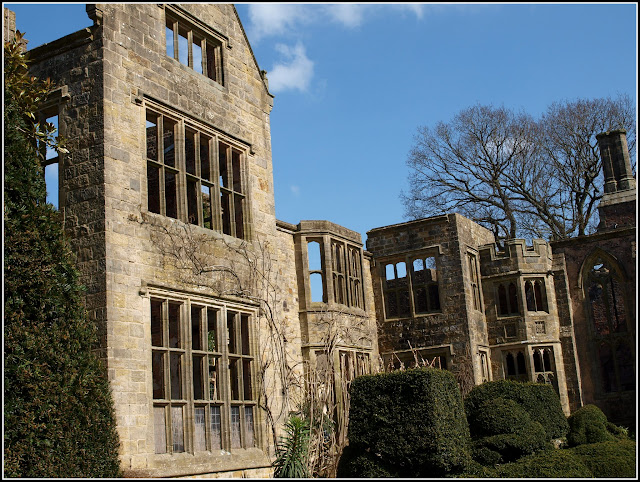This property has a very unfortunate history, since the main part of the house was destroyed by fire in 1947. Today, the stark ruins are the centrepiece for a fabulous garden famous for its diversity. Long-distance views over the archetypically English Sussex Weald are interspersed with intimate cameos of European, Oriental and South African gardens.
We were very lucky with the weather, which at this time of year might well have been cold, wet and windy. While we were there the sun shone and the sky was blue and almost, perfect conditions for admiring the gardens, though the harsh light conditions were tricky for photography.
Throughout the gardens there were swathes of Daffodils and Narcissi of various sorts - so characteristic of Springtime in England:
One of the most interesting features of the property is a circular garden, divided into four segments by broad gravel paths which meet at a central fountain guarded by four closely-clipped Yew trees:
Here's a close-up of the fountain feature:
What a snooty turned-up nose, eh? In the walled garden are many magnificent Magnolia trees, currently in full flower:
Underneath the trees is a profusion of Snakehead Fritillaries, mostly the pink/purple ones, but with a smattering of the white type.
The beetroot-red leaves seen here are Bergenia, with purple Heather in the background.
There were clumps of Cyclamen in many, many places - often in shady spots at the base of a big tree.
This is Hammamelis, aka Witch Hazel:
I was hugely impressed with this Libertia Peregrinans. If you want some Late Winter colour, this would be hard to beat!
Quite apart from the plants, Nymans has a lot of "hard landscaping" features, like walls, pergolas, platforms, stone benches etc, but my favourite was this octagonal dovecote:
There is not much remaining of the house, just a few small rooms, and the majority is a ruined shell. I bet the bats like it!
In the house at present there is a small but very impressive exhibition of stained glass works of art created by Elizabeth Lamont, entitled "Dreams behind the scenes". It is inspired by some of the artefacts belonging to the Messel family who owned the property at the time of the fire. For copyright reasons, photography of the items is forbidden. However, if you want to see what they are like, follow this LINK:
Also in the grounds is the workshop of painter John Thompson, where you can see paintings like this being created:
Some aspects of a garden you don't appreciate at the time: reading about Nymans on the NT website, I see that they are very proud of their "green" (environment-friendly) credentials. For instance they have tanks for saving approximately 150,000 litres of rainwater for irrigation purposes, and annually make about 44 tonnes of compost. All in all this is a fascinating place, full of interest at any time of year. It's one of those places I would like to visit about once every three months, just to see how the garden changes with the seasons.
















We visited Nymans a couple of years ago, although we were there in late October, so didn't see the Spring plants. But we were lucky with the weather so it was still very lovely indeed.
ReplyDeleteWhat a wonderful place; I'm fascinated by ruins and love the fact that they didn't tear down the house after the fire...something you don't often see.
ReplyDeleteHow beautiful, and the ruins are quite romantic.... it conjures emotions of time and loss, but the spring blossoms also bring hope.
ReplyDelete